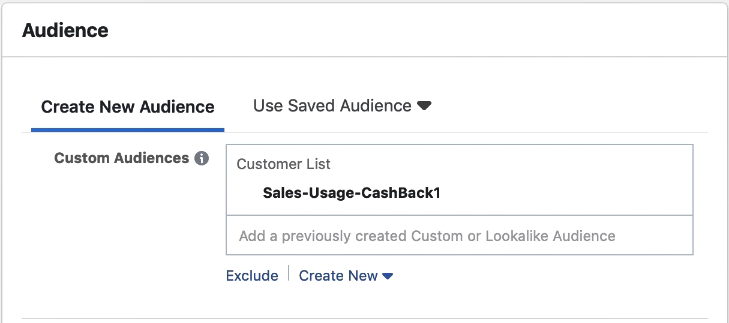Reducing wasted ad spend with the NBA Known Targeting tactic
Advertising on paid channels without a centralized Next-Best-Action strategy has the risk of wasting ad spend on ads which are not relevant to the individuals whom you want to target. For example, an individual may see an ad for a product which he or she already has, because the information is not communicated from your Pega Customer Decision Hub application to the paid destination where you are advertising. The cost of that impression is likely wasted and would be better spent on showing the ad to an individual for whom the product offer is more relevant.
Paid Media Manager addresses this issue by communicating relevant Next-Best-Action decisions to the destination platform, according to the engagement policies specified in the Eligibility section of the Next-Best-Action Designer. This means that after individuals with accounts on the destination platform are matched based on a one-way hash of their personally identifiable information (PII), such as an email address, phone number, or device ID, they are placed in audiences only for products for which they are eligible. This ensures that ad spend is not wasted by showing the individual offers which are not relevant to them.
For example, while browsing his Facebook feed, Troy may see ads from UPlusBank, but before UPlusBank enabled Paid Media Manager to communicate Next-Best-Action decision to paid channels, Troy sometimes saw ads which were not relevant to him, for example, ads for the same type of checking account which he already had.
After UPlusBank extends their Next-Best-Best-Action to paid channels, information about each individual's Next-Best-Action is communicated to Facebook Ads. Individuals are placed into custom audiences, with each audience consisting only of individuals who are eligible for a particular offer. Each audience is associated with an ad set, which contains one or more ads for the offer. One of Troy's Next-Best-Actions is determined to be a cashback credit card offer, so he is added to the Sales-Usage-CashBack1 audience set, which is targeted with an ad set configured with associated advertisements.

As a result, Troy now sees an ad for the cashback credit card in his Facebook feed.
The below tasks describe how to configure Paid Media Manager so that it can create audiences based on the offer eligibility data you have collected in your Pega Customer Decision Hub application.
- Triggering paid updates through Next-Best-Action
After you configure the connection to a paid destination and specify how individuals are matched to their accounts on that destination, use the Next-Best-Action Designer to enable Next-Best-Action decisions for paid channels.
- Responding to individual engagement on paid channels with real-time events
You can define real-time events that correspond to real-time engagement opportunities on paid destinations.
- Aligning ad spend based on action priority
To further optimize your advertising, use a paid strategy to convey offer priority to ad platforms which can then be aligned with the willingness to pay for each individual and action as a factor in targeting individuals with actions.
- Reducing wasted ad spend based on destination-specific interaction results
Individuals interact with your actions, for example, by clicking a link in the ad, accepting or rejecting the offer, or ignoring the action altogether. The individual's preferences captured in the results of these interactions can be used to increase the accuracy of adaptive models and leverage destination-specific responses.
- Reduce wasted ad spend based on the predicted value of a click
Use the interactions recorded by the PaidCaptureResponse service to predict whether clicking on an ad would increase an individual's propensity to accept an offer, and therefore to align the willingness to pay with the predicted value of a click.
Previous topic Enabling offline conversions Next topic Triggering paid updates through Next-Best-Action
